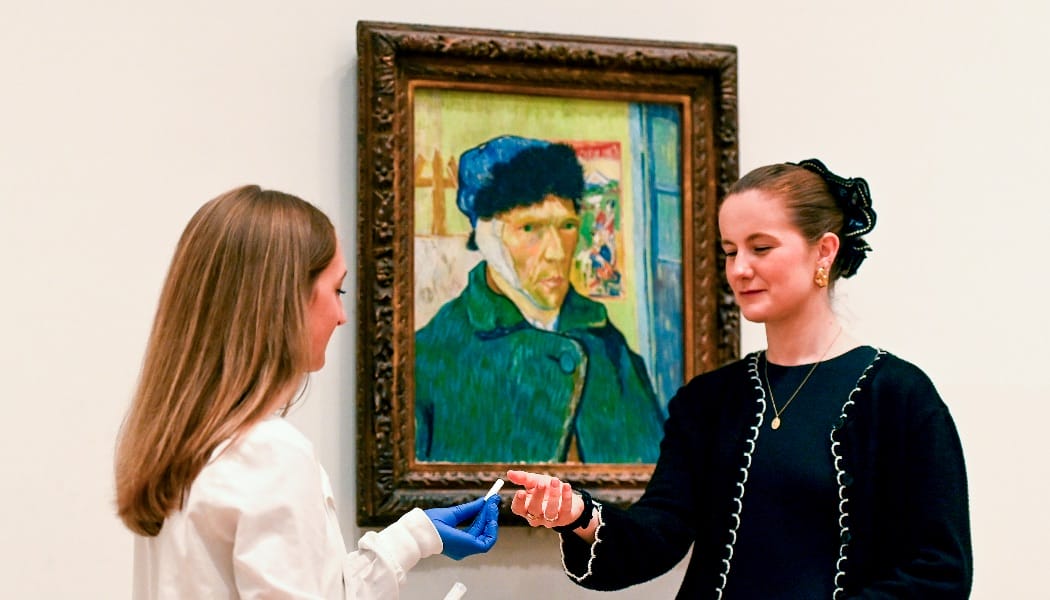Alistair Hardaker
Image: Researcher and participant fromArt Fund commissioned King's College London study
King’s College London research measures real-time health impacts of gallery visits at The Courtauld Gallery, showing 22% cortisol reduction
A study undertaken by King’s College London has presented scientific evidence that viewing original art in galleries delivers immediate physiological benefits.
The findings offer museums and cultural institutions new evidence-based advocacy for their role in public health and wellbeing.
The research was initiated by Art Fund’s National Art Pass and co-funded by Art Fund and the Psychiatry Research Trust. It measured the real-time physiological responses of 50 participants aged 18-40 who viewed masterpieces at The Courtauld Gallery in London between July and September 2025.
The study compared their responses with a control group viewing reproductions of the same paintings in a non-gallery environment.
Stress reduced
Participants viewing original works by Manet, Van Gogh, Gauguin and Toulouse-Lautrec experienced a 22% reduction in cortisol levels. This compared with just 8% for those viewing reproductions.
Levels of two key inflammation markers in the body, L-6 and TNF-α, were around 30% lower in people who visited the gallery, while no change was observed in the reproduction group.
Researchers used research-grade digital watches to monitor heart rate variability and skin temperature. Saliva samples measured cytokine and cortisol levels, which when lowered suggest reduced stress or inflammation in the body.
Dr Tony Woods, researcher at Kings College London said the research had revealed unique findings, and the team was “genuinely surprised” to conclude art had a positive impact on three different body systems “the immune, endocrine and autonomic systems – at the same time.”
“Stress hormones and inflammatory markers like cortisol, IL-6 and TNF-alpha are linked to a wide range of health problems, from heart disease and diabetes to anxiety and depression. The fact that viewing original art lowered these markers suggests that cultural experiences may play a real role in protecting both mind and body.”
Excitement increased
Participants also showed physiological signs of excitement whilst viewing art. These included temperature drops of 0.74°C and more variation in heartbeat patterns. Overall heart rates were higher, indicating emotional arousal. Dr Woods described this as “effectively a ‘cultural workout for the body'”, adding: “In short, our unique and original study provides compelling evidence that viewing art in a gallery is ‘good for you’ and helps to further our understanding of its fundamental benefits. In essence, Art doesn’t just move us emotionally — it calms the body too.”
The research revealed that neither personality traits nor emotional intelligence influenced responses. This suggests the health benefits are universal. Previous studies have linked regular gallery visits to long-term wellbeing. The King’s College London research captured real-time physiological changes during art viewing.
The Chair of the Psychiatry Research Trust, Professor Carmine Pariante, added: “We are delighted to have worked so collaboratively with the Art Fund. The Trust funds research and education in mental health and this type of interdisciplinary research, relevant to both science and wellbeing, is exactly the type of studies that are needed to understand how arts influences both mind and body.”
The research, available here, has not yet been peer reviewed. The artworks viewed during the study included Henri de Toulouse-Lautrec’s Jane Avril in the Entrance to the Moulin Rouge (c. 1892), Édouard Manet’s A Bar at the Folies-Bergere (1882) and Banks of the Seine at Argenteuil (1874), Vincent van Gogh’s Self-Portrait with Bandaged Ear (1889), and Paul Gauguin’s Te Rerioa (The Dream) (1897).





